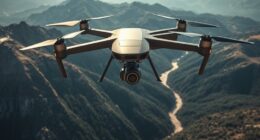The Five Eyes alliance began during World War II as a secret partnership among the US, UK, Canada, Australia, and New Zealand to share intelligence quickly and securely. Originally focused on wartime cooperation, it evolved into a sophisticated network supporting covert operations, technology sharing, and strategic security efforts. Trust and collaboration built over decades help prevent threats and gather crucial security information. To learn how this alliance continues to shape global safety today, keep exploring its history and evolution.
Key Takeaways
- Established during World War II as a secret intelligence-sharing partnership among five nations.
- Created to enable rapid, secure communication and cooperation for wartime intelligence efforts.
- Evolved into a modern alliance supporting covert operations, strategic security, and data exchange.
- Built on trust, mutual interests, and technological advancements to counter global threats.
- Continues to adapt and expand its intelligence capabilities, maintaining a lasting international security partnership.

The Five Eyes Alliance is a secretive intelligence-sharing partnership between the United States, the United Kingdom, Canada, Australia, and New Zealand. Originally forged during World War II, this alliance was built on the need for rapid, secure communication among these nations to counter shared threats. Today, you can think of it as a sophisticated network that enables members to exchange intelligence quickly and efficiently, often in real time, to stay ahead of adversaries. This intelligence sharing isn’t limited to surface-level information; it involves deep, often clandestine data exchanges that support covert operations worldwide. These covert operations involve undercover activities, surveillance, and strategic interventions that are vital for national security. Through this alliance, you’re part of a system that allows member countries to pool resources, technology, and expertise to conduct complex covert actions that might be impossible individually.
From its origins, the alliance’s focus extended beyond open intelligence gathering to include covert operations that require a high level of trust and coordination. When threats emerge—whether from hostile states, terrorist groups, or cyber adversaries—you’re relying on the combined intelligence of all five nations for a thorough picture. This collective effort enhances your ability to detect, disrupt, or neutralize threats before they materialize fully. The secretive nature of the partnership means you often don’t see the full scope of these operations, but their impact is felt worldwide. The alliance’s intelligence sharing capabilities allow you to access a vast pool of intercepted communications, signals, and satellite data, which are fundamental for planning and executing covert operations. Additionally, advances in technology and data analysis continue to strengthen the alliance’s effectiveness and adaptability in an ever-changing threat landscape. You might not always be aware of the specific covert actions, but their success relies heavily on these technological capabilities. This ongoing development ensures that the alliance remains a cutting-edge force in global security efforts. Moreover, this cooperation is essential for staying ahead in the rapidly evolving digital security environment. Recognizing the importance of intelligence integration, these nations continuously refine their methods to improve operational efficiency and security.
The alliance’s effectiveness hinges on the trust established between these countries, as well as their shared commitment to security. You’re part of a system that has evolved from wartime cooperation into a modern intelligence network, adapting to technological advancements and emerging threats. While some critics raise concerns about privacy or overreach, the primary goal remains protecting your freedoms by keeping dangerous elements at bay. The alliance’s history demonstrates that when nations work together secretly and efficiently, they can preempt crises, dismantle terrorist networks, and gather critical intelligence—often before anyone else even knows a threat exists. Overall, the Five Eyes isn’t just about sharing information; it’s about creating a unified front that relies on covert operations and intelligence sharing to keep your world safer. This unity is reinforced by shared values and mutual interests, which foster long-term cooperation beyond immediate threats.
Frequently Asked Questions
How Has the Five Eyes Alliance Evolved Since WWII?
You see the Five Eyes alliance has grown beyond its WWII roots, strengthening cybersecurity cooperation and sharing intelligence more effectively. You notice how members now coordinate on diplomatic espionage, tackling modern threats together. Over time, they’ve modernized their operations, adopting new tech and strategies. This evolution helps you understand how a partnership born in war continues to adapt, ensuring collective security in an increasingly digital world.
What Are the Primary Intelligence Sharing Protocols?
You might think intelligence sharing is simple, but it’s actually complex, especially with cryptographic standards and signal sharing protocols. You’re expected to follow strict protocols that guarantee secure information exchange among allies. These protocols include standardized encryption methods and secure channels, designed to prevent leaks and maintain trust. Ironically, despite all this complexity, the core goal remains seamless, reliable communication to keep everyone safe and in sync, no matter what.
How Do Member Countries Balance Privacy and Security?
You balance privacy and security by maneuvering cryptography debates and privacy legislation carefully. While sharing intelligence, you respect individual rights and guarantee data encryption protects personal information. Governments implement laws to regulate surveillance, aiming to prevent overreach. You stay informed on legal updates and technological advances, finding a middle ground that maintains national security without compromising privacy. Open dialogue and transparency help you adapt strategies that respect both security needs and personal freedoms.
Are There Any Known Disagreements Among Five Eyes Partners?
Imagine a tightly woven fabric fraying at the edges—that’s how disagreements among Five Eyes partners often appear. You should know that diplomatic tensions and technology disagreements sometimes surface, especially over surveillance methods or data sharing. While they endeavor for unity, these issues can cause friction, like sparks flying in a storm. Yet, their shared history helps them patch things up, maintaining the alliance’s strength despite occasional disagreements.
What Future Challenges Does the Alliance Face?
You face future challenges in the alliance, especially around cybersecurity cooperation and emerging technological threats. As nations evolve and new digital vulnerabilities appear, maintaining trust and effective info sharing becomes harder. You’ll need to adapt policies quickly and foster stronger collaboration to counter cyber attacks and technological risks. Staying ahead in innovation and ensuring joint responses are essential to keep the alliance resilient amid these growing global security concerns.
Conclusion
So, after all these years of spying on each other and sharing secrets, you’d think the Five Eyes alliance would be anything but enduring. Ironically, it’s precisely their mistrust that keeps them united—each partner secretly counting on the others to watch their backs. Who knew that a little paranoia and a whole lot of surveillance could turn into one of the world’s longest-lasting friendships? Guess some alliances are built on secrets… and suspicion.







